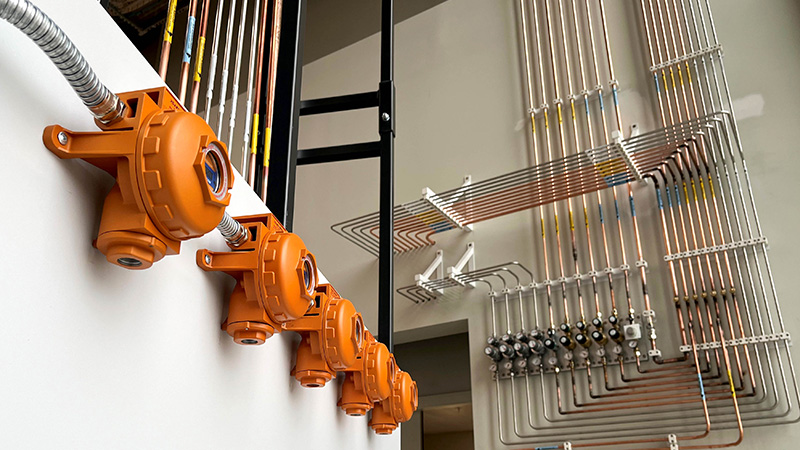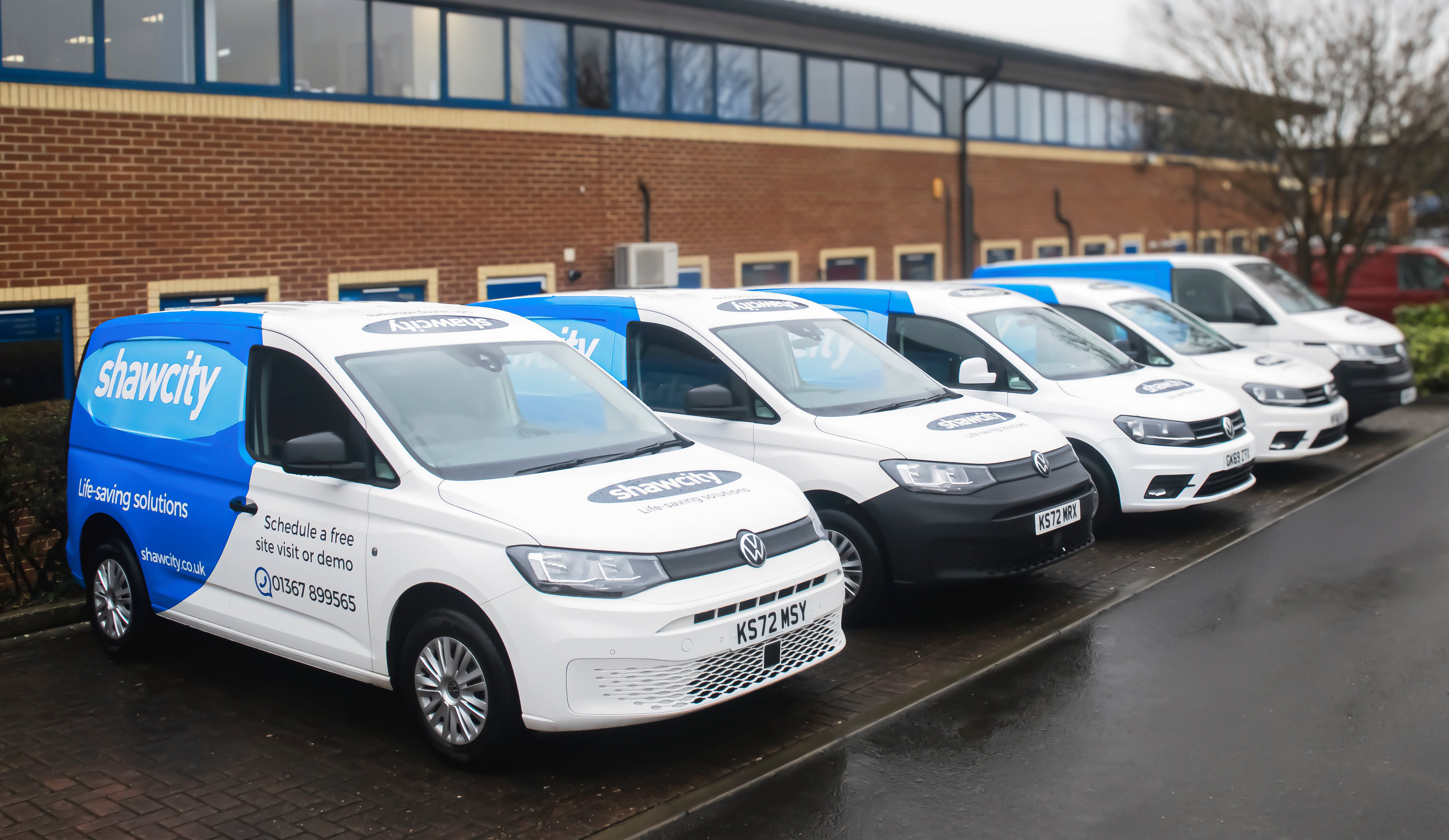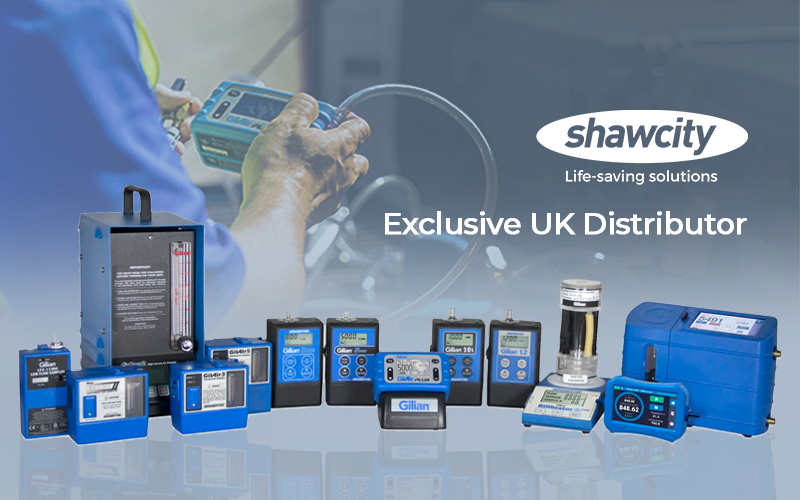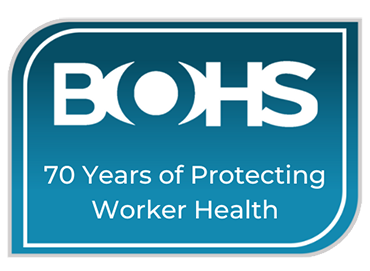Fixed-point detection systems are permanent installations designed to provide continuous monitoring of gas levels in a wide range of environments, from commercial premises to heavy industrial settings.

Systems can be designed to detect one or multiple gases and can be installed in single rooms or networked across large workspaces with hundreds of sensors. They can also be incorporated into new or existing safety or building managements systems (BMS) and include pre-entry data for hazardous areas.
The list of suitable applications for fixed systems is extensive and wide-ranging but can include automotive, aviation, battery manufacturing, boiler houses, bottling plants, breweries, chemical manufacturing, electrical engineering, energy production, environmental, food production, healthcare, HVAC, laboratories, motorsport, oil & gas, spray booths, pharmaceuticals, printing, packaging and waste services.
Gas detection is used to manage three main types of gas risk categories: Flammable, toxic and asphyxiant. Some of these risks are an immediate threat to life, while others can be detrimental to health over longer exposure periods. Continuous monitoring is therefore sometimes essential to ensure exposure limits are not exceeded, protecting the workforce and the surrounding environment.
Flammable gases such as butane, carbon monoxide, hydrogen, methane and propane can be the cause of fires and potentially explosive when mixed with air or oxygen in the right proportions. Even a small leak can potentially fill an area with a potentially explosive atmosphere, so strict, continuous monitoring is required due to their high flammability and potential to form explosive mixtures when combined with air. Fixed gas detection systems with ATEX-certified sensors are vital for ensuring safety in these demanding environments.

Toxic gases, such as carbon monoxide, hydrogen sulphide, ammonia, chlorine and formaldehyde, introduce a risk of serious health issues or even death at high enough concentrations. Some toxic gases are also flammable, or can be found in areas where flammable substances may be present, so it is advisable and often essential to use instrumentation which is certified safe for use in explosive atmospheres.
Asphyxiation can be caused by insufficient levels of oxygen, which can be displaced by gases such as carbon dioxide, nitrogen and argon or consumed by environmental factors including rusting metal, drying paint or even fruit as it ripens. Oxygen-enriched atmospheres can lead to serious consequences, including slow-burning materials burning more vigorously and greases and oils igniting.
Volatile organic compounds (VOCs) are a wide range of naturally and synthetically occurring chemicals that are found almost everywhere on earth. They are described as volatile because they evaporate at standard temperature and pressure, releasing molecules into the atmosphere.
VOCs are widely used and extremely useful as they form the building blocks of many synthetic materials (plastics, rubbers, glues, paints, etc.), are used to create pharmaceuticals and are a great fuel for transport and heating. However, because of their potential toxicity, they can also contribute to a variety of health issues including eye, nose and throat irritation; headaches and loss of co-ordination; nausea. Some VOCs are known or suspected carcinogens and can cause damage to the liver, kidneys and central nervous system. A fixed gas detection system can ensure safety through the continuous monitoring of VOCs.
Benzene, also a volatile organic compound (VOC), is particularly challenging to detect in isolation from other VOCs. Traditional detection equipment can struggle to accurately measure down to low parts per billion (ppb) concentrations while also operating in some of the harshest possible conditions, so highly sensitive and specialised fixed sensors are required for accurate benzene monitoring performance.
Fixed systems are made up of a variety of different components such as gas sensors, sampling systems, addressable controllers, control panels, display panels, alarms, repeater displays, lights and sounder beacons with digital and analogue options, depending on the performance required for the application. Expert suppliers will have the knowledge to integrate new system components with existing safety controls and seamlessly blend technology from different manufacturers to create bespoke systems designed to suit every budget and safety requirement.
Site-wide warnings can be integrated into fixed systems, offering data from numerous areas which can be analysed within a central control room or even remotely. If abnormalities are detected or limits exceeded, automatic alerts and safety measures such as automatic valve shutdowns and ventilation adjustments can be activated to provide instant safety measures, alongside options to remotely shut down individual areas and isolate hazards.

There are many aspects to consider when considering installing a fixed gas detection system. For example, they are not suitable for calculating time-weighted average (TWA) exposures found on the HSE’s EH40/2005 list, because they cannot accurately reflect the amount that could be inhaled by a worker. They are also more expensive than portable solutions and one size does not fit all.
However, fixed systems can come into their own: Where continuous monitoring is necessary; when permanent pre-entry checks to an area are required; determining background workplace contaminant concentrations; where wearing personal monitoring equipment may introduce additional hazards; and where there are no suitable personal monitoring methods available.
Fixed systems are always individually tailored to each specific site, designed to protect against a unique set of risks. The best place to start is with a comprehensive site survey, to establish exactly which gases need to be monitored as well as identifying any other potential hazards from substances on site, such as cross-contamination, which can create false readings if not identified and factored into system functionality.
Ongoing servicing and maintenance are critical for fixed gas detection, to ensure the system continues to work correctly. Following manufacturer recommendations for scheduled checks protects against sensor drift or system failure. Many environments which require continuous monitoring can also be extreme in terms of weather or with other hostile substances present, which may even shorten the expected life of gas sensors due to contamination or poisoning. So, expert advice is key to ensuring the ongoing safety of the workforce as well as the surrounding environment.
In terms of choosing your fixed system provider, look for companies who are ISO-certified and SafeContractor accredited, and whose engineers are CSCS and SSSTS-certified. Those who offer CompEx-certified work are validated as competent to work in explosive atmospheres, critical for many industries including oil and gas, chemicals, pharmaceuticals, food manufacturing and utilities.
Cloud-based datalogging is still relatively new to the fixed gas detection industry, but some companies have already developed fixed systems with this capability. Where a typical fixed system is run by a control panel, alarms will be activated when gas levels exceed set limits. The system will immediately alarm on-site, alerting those in the proximity of the incident. While it offers many benefits, a control panel will demonstrate that a situation has developed, but not why.
Innovators in the industry have designed additional solutions for fixed systems which can either transmit data via a 4G uplink device straight to the cloud or alternatively plug into the customer’s existing IT infrastructure. With datalogging intervals as frequent as every 60 seconds, teams monitoring the system can now access ‘real-time’ data remotely, from any location worldwide.
When a cloud-based system goes into alarm, an alert will automatically be sent via selected pre-programmed communications channels - including SMS text messages, emails or phone - which will be received by the user on call out of hours or the site security office, for example. These systems can also be designed without a local control panel altogether, offering vital cost savings to the customer.
Advantages of this elevated visibility include viewable historical data relating to every aspect of the system to understand what events have preceded an alarm situation, including any downtime, as well as all previous alarm history. It allows remote users to pinpoint exactly which sensor is alarming and what the gas levels are for each, to support and guide efforts at the incident site. This data reporting capacity is also incredibly useful in terms of compliance, with data available for download at the click of a button.
Capable of supporting a virtually unlimited number of sensors, this type of device’s ‘plug and play’ design offers access to the industrial Internet of Things (IoT) and has proved to be a very popular innovation with customers. Simple to manage, the deployment involves a single, one-off cost for the equipment and access to the software, while a monthly SIM card cost is included within the monthly service and maintenance package.

Shawcity is one of the UK’s leading providers of fixed detection system installations, servicing and maintenance. They offer a wide range of bespoke systems from a selection of world-leading manufacturers, as well as comprehensive maintenance and service plans.
For further information, please contact the Marketing Department at Shawcity Ltd:
Tel: 01367 899419
marketing@shawcity.co.uk
www.shawcity.co.uk
Instrument House, 91-92 Shrivenham Hundred Business Park, Watchfield, Oxfordshire SN6 8TY

-1.png)









